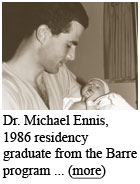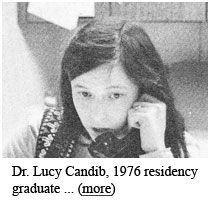A Specialty for Generalists (cont'd.)
Family Medicine arose in a much different context from general practice. As a distinct field it came into existence in an era often characterized as "post-Flexnerian," that is, a tradition identified with the 1910 report of Abraham Flexner—a call to arms for the infiltration of scientific thinking and, if possible, research into all aspects of medical care, a move facilitated by the increasingly close affiliation of medical schools with universities. Thus the advocates for Family Medicine were determined to shape a specialty that would encompass both a clinical and a research imperative. Given the explicitly holistic, anti-reductionist frame of mind of family medicine, some rationale or theoretical underpinning was required for this approach to understanding the connections between health, illness, and disease. As Dr. Dan Doyle, a member of the second graduating class of the UMass residency told us,
… there was an ideology of Family Medicine that had to do with knowing the whole patient. The buzz word 'biopsychosocial' hadn't come around, but really that's what it was, a biopsychosocial approach, knowing the whole person, the importance of the family, caring for families together, so while the ideology of Family Medicine wasn't politically progressive, [it] was very congruent with that perspective of caring for the underserved and recognizing the importance of the culture of the patient and also trying to minimize social distance between the doctor and the patient.(17)
Stephens wrote in 1981, "Family doctors do primary care [but they] do more than primary care…" This does not mean, however,
that they claim to know "everything" about medicine. Rather, family medicine's claim to "breadth" or "comprehensiveness" or care for
"the whole person" really stands for a belief that no aspect of the patient's life is off-limits to the physician as she or he tries to
arrive at a diagnostic resolution. Moreover, the very act of trying to understand the patient as a person and his or her illness as a
function of her personhood, requires, in Stephens's words, "a therapeutic relationship
between patient and doctor that is not only concerned with
taking the patient's history, but which allows both to meet as real persons."
 Family physicians are not the only ones who try to
accomplish this, but they are the only ones to make it the centerpiece of their theory of practice. This way of being with patients is
the subject of a book by John Berger, A Fortunate Man: The Story of a Country Doctor, a book that is widely acknowledged as a
touchstone
for many of the physicians who entered practice in the 1960s and 1970s. Berger's nearly iconic portrait of Dr. John Sassall, an English
country doctor, concluded with Sassall's own words: "'Whenever I am reminded of death—and it happens every day—I think of my
own, and this makes me try to work harder.'" In Berger's words, "When we call for a doctor we are asking him to cure us and to relieve
our suffering, but, if he cannot cure us, we are also asking him to witness our dying … This individual and closely intimate
recognition is required on both a physical and psychological level [for] diagnosis and support."(18)
Family physicians are not the only ones who try to
accomplish this, but they are the only ones to make it the centerpiece of their theory of practice. This way of being with patients is
the subject of a book by John Berger, A Fortunate Man: The Story of a Country Doctor, a book that is widely acknowledged as a
touchstone
for many of the physicians who entered practice in the 1960s and 1970s. Berger's nearly iconic portrait of Dr. John Sassall, an English
country doctor, concluded with Sassall's own words: "'Whenever I am reminded of death—and it happens every day—I think of my
own, and this makes me try to work harder.'" In Berger's words, "When we call for a doctor we are asking him to cure us and to relieve
our suffering, but, if he cannot cure us, we are also asking him to witness our dying … This individual and closely intimate
recognition is required on both a physical and psychological level [for] diagnosis and support."(18)
Such a philosophy of medicine fit well with the atypically egalitarian, counter-cultural moment in American society with which the discipline's early years coincided. Many of the first generation of family practitioners, roughly those in the field from the mid-1960s through the 1970s, shared a philosophy of social activism and a pronounced commitment to the provision of health care to all segments of society. In the words of Dr. Dennis Dimitri, currently the Vice Chair for Clinical Affairs for the Department of Family Medicine and Community Health at UMMS and a 1982 graduate of the program,
[T]he very fact that you were doing family medicine instead of some other more narrow specialized pursuit or an academic pursuit or whatever, was in and of itself … an indication of a different level of social responsibility … I don't want to overstate what we were doing, but I really feel strongly that it was very much more a kind of a social statement and calling to go into family medicine back in the 1970s than it might be today.(19)
The efforts to launch Family Medicine as a residency-based specialty thus coincided with an upsurge of political and social activism
throughout American society and in many other Western nations. In the United States, the Civil Rights and anti-Viet Nam War movements
insistently brought social inequality to the attention of the nation's political leaders and citizens during this same period. The
first two federally funded, neighborhood health centers (later called community health centers) were founded in 1965 as part of the
Office of Economic Opportunity's "War on Poverty," and were a direct outgrowth of the work of civil rights organizers in Mississippi the
previous summer. By 1974, when the residency program began at UMass, 168 federally funded health centers were in existence, all
 dedicated to the idea of continuous, comprehensive family and community health care.
Physicians calling for a renewed covenant with the underserved through the mechanism of primary care medicine now found ample support
from without the profession and growing consensus from within it.(20) The effort to meld the best of general
practice with the best of
modern health care was a goal that energized the founders of the new specialty, Family Medicine.(21) Many of the first
classes of Family Medicine residents felt similarly to what Dr. Lucy Candib, who joined the residency as a second-year resident in 1974
after several years of feminist activism while in medical school at Harvard, recalled as her motivation to join the program: "I had
decided family medicine would let me develop the medicine side and keep the activist side."(22)
dedicated to the idea of continuous, comprehensive family and community health care.
Physicians calling for a renewed covenant with the underserved through the mechanism of primary care medicine now found ample support
from without the profession and growing consensus from within it.(20) The effort to meld the best of general
practice with the best of
modern health care was a goal that energized the founders of the new specialty, Family Medicine.(21) Many of the first
classes of Family Medicine residents felt similarly to what Dr. Lucy Candib, who joined the residency as a second-year resident in 1974
after several years of feminist activism while in medical school at Harvard, recalled as her motivation to join the program: "I had
decided family medicine would let me develop the medicine side and keep the activist side."(22)
Here is a sampling of what other first-generation family physicians from Worcester told us about their fundamental worldview:
One of the things I really remember from … Lucy Candib, who was over at Main Street, I can't say this as eloquently as she did, and I don't remember the exact context of it, but I remember her talking once, it must have been at some residency program event, about the importance of, as a family physician, the importance of embedding yourself into the community where you practice and not just seeing it as a place where you might come in and have a job for a few years and then move on because you've got some academic aspirations or whatever else, but if you really wanted to do family medicine, that you lived in the community, you joined the community in whatever ways work for you.--Dennis Dimitri
John Frey, who was the residency director and also was working at Main Street when I came, and he actually had been a year ahead of me at Notre Dame and we had just known each other superficially, but he was really important. And his enthusiasm for Family Medicine, and … two of the really important things he taught me and reminded me were about the opportunity for continuity of care in Family Medicine, the value of continuity, the importance of sometimes using waiting as a diagnostic test instead of x-rays and blood and CT scans, the value of the doctor-patient relationship, both as creating a human bond and interaction in health care and also as a way of arriving at a way of both diagnosis and treatment and caring, which was a significant difference from a strictly biomedical approach that I had mostly seen and been taught in my years as a medical student, in Harvard Medical School and at Cambridge City Hospital, so he was really really important in that respect for me.--Dan Doyle
Fast forward [to] my pediatrics rotation, and 90% of the class went to Buffalo Children's Hospital and 10% did their rotation at the County Hospital. I did my rotation at the County Hospital. The County Hospital had a room, a big semi-circular ward, that we called the lead room because it was populated with children who had been admitted for lead poisoning, and they were all getting chelation therapy, two or three days of IV therapy to get the lead out. While the rest of the class was off learning about cystic fibrosis and leukemia and all kinds of esoteric medical diagnoses, I was there with a room full of kids with lead poisoning from housing, from eating lead paint. So again it was clear that there was a lot more to health care than making a diagnosis. The director of that unit was a very community-oriented pediatrician named Henry Staub from Minneapolis, and I learned more about community health in that rotation, I didn't learn any pediatrics, but I learned how to take care of children in a community.--Dan Lasser
There was something about Lucy [Candib] and John [Frey] as people that really appealed to me, and watching them function with patients, and the kind of respect that they showed to patients, and the type of attitude they had of one of being in service to their patients, really appealed to me. That sense about being able to take care of the entire family, caring about them, treating people with respect, was new to me. I had seen in medical school the importance of learning good medicine and doing the right thing, but this was the first time I really felt that I had an example of the kind of person that I could be as a physician.--Robert Singer
